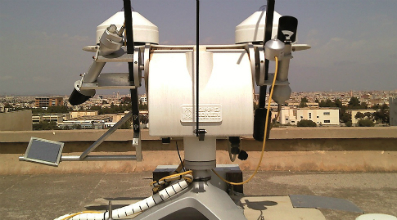Once a power plant has passed commissioning and is running at the best possible level, from the engineering point of view, one of the most efficiency-limiting parameters is the decreasing cleanliness of solar reflectors and receivers caused by soiling; i.e. the accumulation of dirt (aerosol and sand particles, dust, biological matter, etc.) on their surfaces. This can cause weekly efficiency loss well above 10%.
The losses due to soiling of power plant components are reduced by cleaning. However, cleaning causes an increase in maintenance costs and water use, even when using sophisticated robots. Therefore researchers and maintenance teams at power plants are aiming at cost optimization for cleaning strategies. The currently employed soiling measurement methods allow only very few measurement points in time and are rather tedious. As measurement methods improve, the effects of different mitigation strategies can be studied in more detail, taking into account the highly non-linear behaviour of soiling characteristics.
 TraCS stands for Tracking Cleanliness Sensor. A precise solar monitoring station that is already used in resource assessment, or in a running power plant, serves as a basis for the installation. It consists of a sun tracker with two pyranometers for measuring the diffuse and global horizontal irradiances (DHI and GHI) and a pyrheliometer for the measurement of direct normal irradiance (DNI). The TraCS installation adds an extra accessory to the tracker, a second pyrheliometer looking backwards into a mirror that reflects the DNI back into the pyrheliometer.
TraCS stands for Tracking Cleanliness Sensor. A precise solar monitoring station that is already used in resource assessment, or in a running power plant, serves as a basis for the installation. It consists of a sun tracker with two pyranometers for measuring the diffuse and global horizontal irradiances (DHI and GHI) and a pyrheliometer for the measurement of direct normal irradiance (DNI). The TraCS installation adds an extra accessory to the tracker, a second pyrheliometer looking backwards into a mirror that reflects the DNI back into the pyrheliometer.
Dividing the reflected DNI signals by the directly measured DNI signals gives the reflectivity of the sample mirror. Normalizing this to the value measured with a clean mirror gives the parameter of cleanliness in real-time whenever the sun is shining.
TraCS is a new and accurate measurement system for the cleanliness of solar mirrors, with the advantage of using the natural sun spectrum and measuring at a high time resolution. It has been validated successfully and the limits for the best measurement conditions have been determined. It can be adapted to specific power plant conditions regarding the acceptance and reflectance angles. A correlation of the soiling to other weather parameters measured simultaneously at the same site will pave the way to a more global understanding of this poorly investigated parameter.
Furthermore, the TraCS accessory can be used to improve the quality of the main DNI measurement of the station respective to the cleanliness of the main pyrheliometer entrance window. This can be detected easily for later correction, even if the sun was not shining during the cleaning of the sensor.
TraCS was designed by DLR and installed at the Université Mohamed Premier in Oujda, Morocco. It has been optimized for more reliable output at the Spanish Plataforma Solar de Almeria (PSA) and is commercially available from the DLR spin-off company CSP Services GmbH in Cologne, www.cspservices.de.
Source: ‘A Novel Method for Automatic Real-Time Monitoring of Mirror Soiling Rates’ by Fabian Wolfertstetter, Klaus Pottler, Ahmed Alami Merrouni, Ahmed Mezrhab and Robert Pitz-Paal